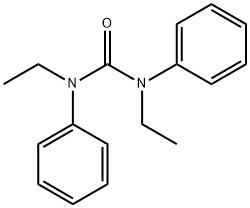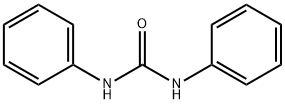1,3-Diethyl-1,3-diphenylurea
- CAS NO.:85-98-3
- Empirical Formula: C17H20N2O
- Molecular Weight: 268.35
- MDL number: MFCD00035794
- EINECS: 201-645-2
- SAFETY DATA SHEET (SDS)
- Update Date: 2024-12-18 14:08:52

What is 1,3-Diethyl-1,3-diphenylurea?
Description
Ethylcentralite (EC), also known as 1,3-Diethyl-1,3-diphenylurea, is a unique compound derived from ethylenediamine, with extensive research focused on its applications in laboratory experiments. The investigation of EC encompasses its potential as an anti-inflammatory, antioxidant, and cognitive enhancer. Additionally, EC shows progression in cancer and neurodegenerative disease research and gene therapy. Furthermore, EC may act as a chelator, effectively binding to metals like iron and copper to prevent their accumulation in the body.
Chemical properties
white crystalline powder
The Uses of 1,3-Diethyl-1,3-diphenylurea
1,3-Diethyl-1,3-diphenylurea is a gunshot residue and a stabilizer for smokeless powder.
The Uses of 1,3-Diethyl-1,3-diphenylurea
As stabilizer of smokeless explosives.
What are the applications of Application
1,3-Diethyl-1,3-diphenylurea is a symmetrical derivative of urea, and a common stabilizer in double-base propellants
General Description
White flakes or white crystalline solid. Peppery odor.
Air & Water Reactions
Insoluble in water.
Reactivity Profile
N,N'-DIETHYL-N,N'-DIPHENYLUREA (1,3-Diethyl-1,3-diphenylurea) is an amide. Amides/imides react with azo and diazo compounds to generate toxic gases. Flammable gases are formed by the reaction of organic amides/imides with strong reducing agents. Amides are very weak bases (weaker than water). Imides are less basic yet and in fact react with strong bases to form salts. That is, they can react as acids. Mixing amides with dehydrating agents such as P2O5 or SOCl2 generates the corresponding nitrile. The combustion of these compounds generates mixed oxides of nitrogen (NOx). N,N'-DIETHYL-N,N'-DIPHENYLUREA is incompatible with acids and oxidizing agents. N,N'-DIETHYL-N,N'-DIPHENYLUREA reacts violently when severely shocked or exposed to extreme temperatures.
Health Hazard
ACUTE/CHRONIC HAZARDS: N,N'-DIETHYL-N,N'-DIPHENYLUREA may react violently when severely shocked or heated to extreme temperatures.
Fire Hazard
N,N'-DIETHYL-N,N'-DIPHENYLUREA is combustible.
Flammability and Explosibility
Non flammable
Safety Profile
Poison by intraperitoneal route. Moderately toxic by ingestion. Combustible when exposed to heat or flame. Probably a slight explosion hazard, although it is a component of smokeless explosive mixtures. When heated o decomposition it burns and emits very toxic fumes of NOx. To fight fire, use dry chemical, CO2, spray or mist. An explosion regulator.
Synthesis
The specific synthesis steps of 1,3-Diethyl-1,3-diphenylurea are as follows: A 10 mL Schlenk tube equipped with a magnetic stirring bar was charged with aryl carbamoyl chlorides and KHCO3, and then Pd(PPh3)4 were added. Finally, 1,4-dioxane was added to the mixture via syringe at room temperature under N2. The tube was sealed and put into a preheated oil bath a 100 °C for 48 h. The mixture was cooled to room temperature, quenched with water, and diluted with ethyl acetate. The layers were separated, and the aqueous layer was extracted with 2 × 5 mL of ethyl acetate. The combined organic extracts were dried over anhydrous sodium sulfate, filtered, and concentrated in vacuo. The crude product was then purified by flash chromatography on silica gel (H), eluting with 30-35% ethyl acetate/petroleum ether.
Properties of 1,3-Diethyl-1,3-diphenylurea
| Melting point: | 73-75 °C(lit.) |
| Boiling point: | 411.52°C (rough estimate) |
| Density | 1.0208 (rough estimate) |
| vapor density | 9.3 (vs air) |
| vapor pressure | 0Pa at 25℃ |
| refractive index | 1.5486 (estimate) |
| Flash point: | 150℃ |
| storage temp. | Sealed in dry,Room Temperature |
| solubility | acetone: soluble(lit.) |
| pka | 0.63±0.50(Predicted) |
| form | Solid |
| color | White to Grey |
| Water Solubility | 40.5mg/L at 20℃ |
| Merck | 13,3144 |
| Stability: | Shock sensitive. |
| CAS DataBase Reference | 85-98-3(CAS DataBase Reference) |
| EPA Substance Registry System | N,N'-Diethylcarbanilide (85-98-3) |
Safety information for 1,3-Diethyl-1,3-diphenylurea
| Signal word | Warning |
| Pictogram(s) |
 Exclamation Mark Irritant GHS07 |
| GHS Hazard Statements |
H302:Acute toxicity,oral H412:Hazardous to the aquatic environment, long-term hazard |
| Precautionary Statement Codes |
P264:Wash hands thoroughly after handling. P264:Wash skin thouroughly after handling. P270:Do not eat, drink or smoke when using this product. P273:Avoid release to the environment. P301+P312:IF SWALLOWED: call a POISON CENTER or doctor/physician IF you feel unwell. P501:Dispose of contents/container to..… |
Computed Descriptors for 1,3-Diethyl-1,3-diphenylurea
1,3-Diethyl-1,3-diphenylurea manufacturer
Prodev Pharma Pvt Ltd
New Products
(S)-3-Aminobutanenitrile hydrochloride 4-Methylphenylacetic acid N-Boc-D-alaninol N-BOC-D/L-ALANINOL Tert-butyl bis(2-chloroethyl)carbamate 3-Morpholino-1-(4-nitrophenyl)-5,6-dihydropyridin- 2(1H)-one Furan-2,5-Dicarboxylic Acid Tropic acid 1-Bromo-3,5-Di-Tert-Butylbenzene S-2-CHLORO PROPIONIC ACID ETHYL ISOCYANOACETATE 2-Bromo-1,3-Bis(Dimethylamino)Trimethinium Hexafluorophosphate 4-IODO BENZOIC ACID 3-NITRO-2-METHYL ANILINE 1-(2,4-DICHLOROPHENYL) ETHANAMINE (2-Hydroxyphenyl)acetonitrile 4-Bromopyrazole 2-(Cyanocyclohexyl)acetic acid 4-methoxy-3,5-dinitropyridine 1-(4-(aminomethyl)benzyl)urea hydrochloride 2-aminopropyl benzoate hydrochloride diethyl 2-(2-((tertbutoxycarbonyl)amino) ethyl)malonate tert-butyl 4- (ureidomethyl)benzylcarbamate Ethyl-2-chloro((4-methoxyphenyl)hydrazono)acetateRelated products of tetrahydrofuran







You may like
-
 N,N'-Diethyl-N,N'-diphenylurea 98%View Details
N,N'-Diethyl-N,N'-diphenylurea 98%View Details
85-98-3 -
 1,3-Diethyl-1,3-diphenylurea CAS 85-98-3View Details
1,3-Diethyl-1,3-diphenylurea CAS 85-98-3View Details
85-98-3 -
 1975-50-4 98%View Details
1975-50-4 98%View Details
1975-50-4 -
 2-HYDROXY BENZYL ALCOHOL 98%View Details
2-HYDROXY BENZYL ALCOHOL 98%View Details
90-01-7 -
 2-Chloro-1,3-Bis(Dimethylamino)Trimethinium Hexafluorophosphate 221615-75-4 98%View Details
2-Chloro-1,3-Bis(Dimethylamino)Trimethinium Hexafluorophosphate 221615-75-4 98%View Details
221615-75-4 -
 61397-56-6 CIS BROMO BENZOATE 98%View Details
61397-56-6 CIS BROMO BENZOATE 98%View Details
61397-56-6 -
 14714-50-2 (2-Hydroxyphenyl)acetonitrile 98+View Details
14714-50-2 (2-Hydroxyphenyl)acetonitrile 98+View Details
14714-50-2 -
 118753-70-1 98+View Details
118753-70-1 98+View Details
118753-70-1